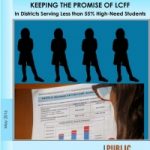California school districts are not providing the level of transparency and accountability promised in exchange for increased spending flexibility under the state’s landmark 2013 education finance reform law known as the Local Control Funding Formula (LCFF), according to two reports recently issues by Public Advocates. Together, these reports call attention to the need for the state and county offices of education to provide closer scrutiny of how school districts, as well as charter schools, are reporting and spending the additional funding generated by students who are low-income, learning English or foster youth under the landmark school finance law.
 In the first report released in April, entitled Keeping the Promise of LCFF: Key Findings & Recommendations After Two Years of LCFF Implementation, Public Advocates outlines findings and recommendations to a wide range of actors in the implementation of the law based on review of dozens of district education and spending plans called Local Control Accountability Plans throughout the state.
In the first report released in April, entitled Keeping the Promise of LCFF: Key Findings & Recommendations After Two Years of LCFF Implementation, Public Advocates outlines findings and recommendations to a wide range of actors in the implementation of the law based on review of dozens of district education and spending plans called Local Control Accountability Plans throughout the state.
“The findings show that many districts have a long way to go to truly fulfill the promise of the law,” said Angelica Jongco, lead author of the report. “In the report we offer specific recommendations and we urge the State Board of Education and County Offices of Education to implement them in order to ensure that districts are respecting both the spirit and the letter of the law.”
 On the heels of this broader survey, Public Advocates released a second report, Keeping the Promise of LCFF in Districts Serving Less than 55% High-Need Students, on May 19th exposing the highly questionable reporting practices of a sample of fifteen California school districts that specifically serve lower concentrations (55% or less) of high-need students. These school districts have a higher burden to explain that any spending district-wide of supplemental funds generated by high-need students is the most effective use of those funds for those students.
On the heels of this broader survey, Public Advocates released a second report, Keeping the Promise of LCFF in Districts Serving Less than 55% High-Need Students, on May 19th exposing the highly questionable reporting practices of a sample of fifteen California school districts that specifically serve lower concentrations (55% or less) of high-need students. These school districts have a higher burden to explain that any spending district-wide of supplemental funds generated by high-need students is the most effective use of those funds for those students.
Many of these districts are failing to report how they are spending tens of millions of LCFF dollars that are supposed to be benefiting English learner, foster youth, and low-income students. Other districts attempt to report how they are spending these funds, but it is not clear how the funds benefit these high-need students and whether they are meeting legal requirements especially where the funds are being distributed district-wide.
Roxanne Hoegger Alejandre, report co-author and volunteer attorney with Public Advocates explains how this practice in particular can significantly short-change high-need students. “We have the example of Orange Unified, a district that spends 79% of its supplemental funds district-wide,” said Alejandre. “In this district one school with only 11% high-need students appears to be benefiting similarly to a school across town with 96% high-need students. This isn’t what the law intended. Districts need to show that spreading the funds across the entire district is the most effective way to increase or improve services for high-need students but they aren’t doing it.”
Our findings are disturbing, particularly since the CA school districts serving fewer high-need students make up 41% of the total number of school districts in the state and these districts receive more than $1 billion in state funds under the new law.
“While we found at least one model district, sadly, most districts brazenly skirt their obligations to these students,” said Rigel S. Massaro, an attorney with Public Advocates and co-author of the report. “Our findings are doubly disturbing if you consider that though these districts have fewer high-need students, the ones they do have are vulnerable to being segregated and ignored because there are likely fewer adults advocating for them.” said Massaro.
For our in-depth analysis on the lack of transparency and accountability in spending and our recommendations, you can view the full report here.

